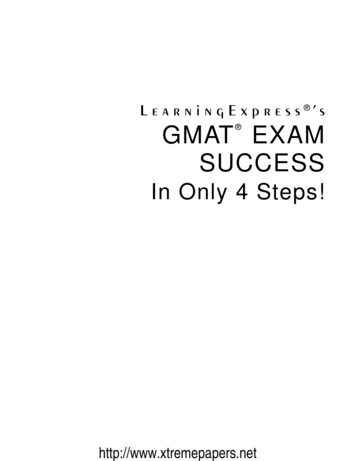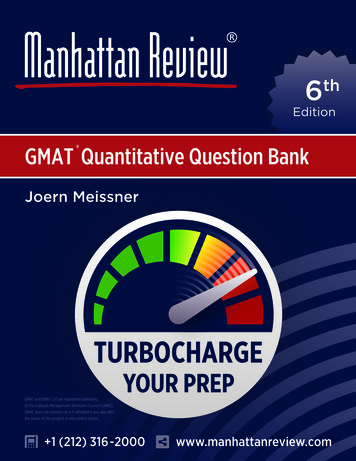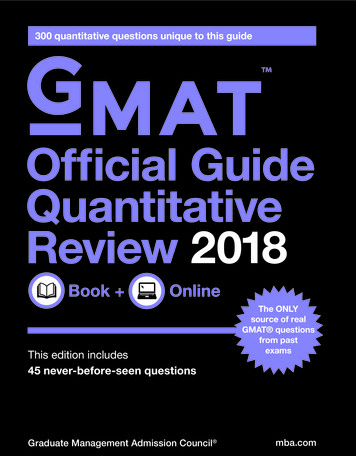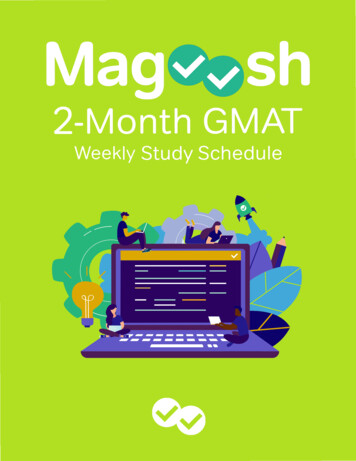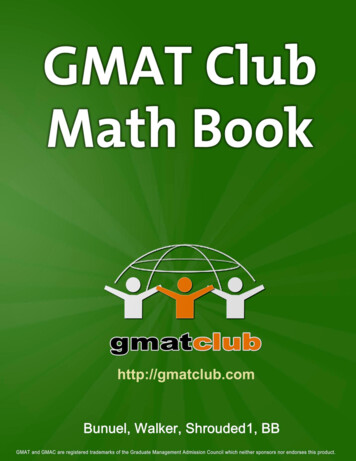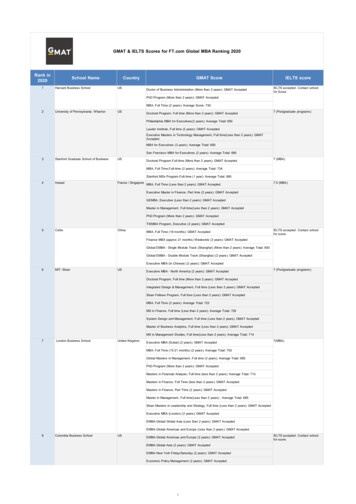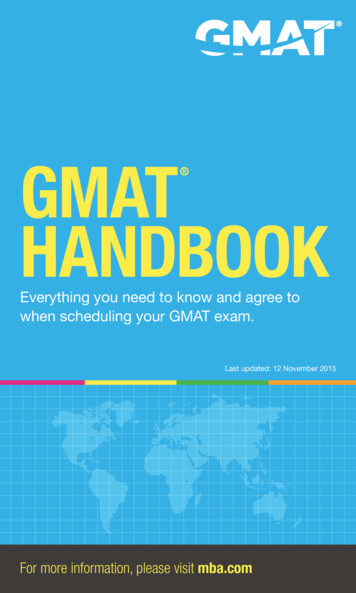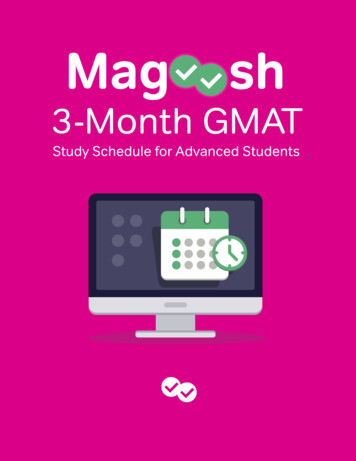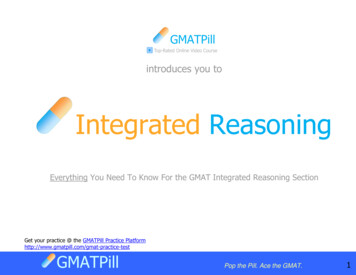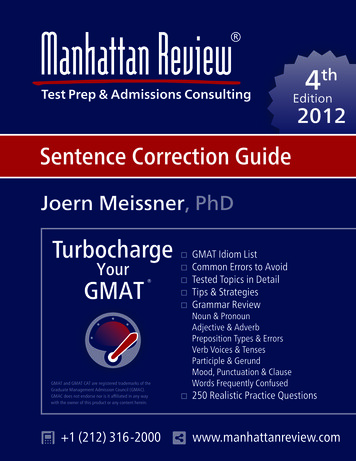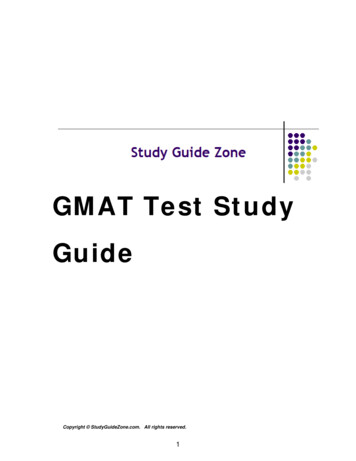
Transcription
GMAC Assessment Products 2018GMAT ExamUser Guidefor Institutions
Table of ContentsWhat is the GMAT Exam?. . . . . . . . . . . . . . . . . . . . . . . . . . . . . . 3How to Become a GMAT Accepting Program. . . . . . . . 12What Does the GMAT Exam Measure?. . . . . . . . . . . . . . . 3Accessing Scores. . . . . . . . . . . . . . . . . . . . . . . . . . . . . . . . . . . . 13Why Do Schools and UniversitiesChoose the GMAT Exam?. . . . . . . . . . . . . . . . . . . . . . . . . . . . . . 4Score Report. . . . . . . . . . . . . . . . . . . . . . . . . . . . . . . . . . . . . . 14The GMAT Advantage. . . . . . . . . . . . . . . . . . . . . . . . . . . . . . . . . 4GMAT Exam Structure and Scores. . . . . . . . . . . . . . . . . . . . . 5Exam Sections. . . . . . . . . . . . . . . . . . . . . . . . . . . . . . . . . . . . . . . . 5Exam Structure. . . . . . . . . . . . . . . . . . . . . . . . . . . . . . . . . . . . . . . . 5Verbal Reasoning (Computer-Adaptive). . . . . . . . . . . 5Quantitative Reasoning (Computer-Adaptive). . . . . . . 5Integrated Reasoning (Not Adaptive). . . . . . . . . . . . . . 5Analytical Writing Assessment. . . . . . . . . . . . . . . . . . . . . 5Fees. . . . . . . . . . . . . . . . . . . . . . . . . . . . . . . . . . . . . . . . . . . . . . . . . . . 6GMAT Scores and Score Scale. . . . . . . . . . . . . . . . . . . . . . . 6Computer-Adaptive Format. . . . . . . . . . . . . . . . . . . . . . . . . . 7Understanding and Using GMAT Exam Scores. . . . . . . . 8Understanding GMAT Scores. . . . . . . . . . . . . . . . . . . . . . . . . 8Management Reports and Market Insight. . . . . . . . . . 8Fairness. . . . . . . . . . . . . . . . . . . . . . . . . . . . . . . . . . . . . . . . . . . . . 8Reliability and Validity. . . . . . . . . . . . . . . . . . . . . . . . . . . . . . 9Standard Errors. . . . . . . . . . . . . . . . . . . . . . . . . . . . . . . . . . . . . 9Percentiles. . . . . . . . . . . . . . . . . . . . . . . . . . . . . . . . . . . . . . . . . . 9GMAT Benchmarking Tool. . . . . . . . . . . . . . . . . . . . . . . . . 10Validity Study Service. . . . . . . . . . . . . . . . . . . . . . . . . . . . . 10 est Practices for Using GMAT ScoresBto Help Select Students. . . . . . . . . . . . . . . . . . . . . . . . . . . . . 11What Doesn’t the GMAT Exam Measure?. . . . . . . . . . 11Cutoff Scores. . . . . . . . . . . . . . . . . . . . . . . . . . . . . . . . . . . . . . 11The GMAT Testing Experience. . . . . . . . . . . . . . . . . . . . . . . . 15GMAT Test Centers. . . . . . . . . . . . . . . . . . . . . . . . . . . . . . . . . . . 15The Test Center Experience. . . . . . . . . . . . . . . . . . . . . . . . . 15Test Security. . . . . . . . . . . . . . . . . . . . . . . . . . . . . . . . . . . . . . . . . 16Appendix 1: Sample Questions. . . . . . . . . . . . . . . . . . . . . . . . . 17Quantitative Reasoning. . . . . . . . . . . . . . . . . . . . . . . . . . . . . . 17Data Sufficiency. . . . . . . . . . . . . . . . . . . . . . . . . . . . . . . . . . . 17Problem-Solving. . . . . . . . . . . . . . . . . . . . . . . . . . . . . . . . . . 17Verbal Reasoning. . . . . . . . . . . . . . . . . . . . . . . . . . . . . . . . . . . . 18Reading Comprehension. . . . . . . . . . . . . . . . . . . . . . . . . . 18Critical Reasoning. . . . . . . . . . . . . . . . . . . . . . . . . . . . . . . . . 19Sentence Correction. . . . . . . . . . . . . . . . . . . . . . . . . . . . . . 19Integrated Reasoning. . . . . . . . . . . . . . . . . . . . . . . . . . . . . . . 20Graphics Interpretation. . . . . . . . . . . . . . . . . . . . . . . . . . . 20Two-Part Analysis. . . . . . . . . . . . . . . . . . . . . . . . . . . . . . . . . 2 1Table Analysis. . . . . . . . . . . . . . . . . . . . . . . . . . . . . . . . . . . . . . 22Multi-Source Reasoning. . . . . . . . . . . . . . . . . . . . . . . . . . . 23Analytical Writing Assessment. . . . . . . . . . . . . . . . . . . . . . 24Appendix 2: Sample Reporting Example. . . . . . . . . . . . . . 25Appendix 3: Sample Score Report. . . . . . . . . . . . . . . . . . . . . 26Additional Resources. . . . . . . . . . . . . . . . . . . . . . . . . . . . . . . . . . . 27Assisting Candidates with GMAT Fees. . . . . . . . . . . . . . . 27Testing Issues. . . . . . . . . . . . . . . . . . . . . . . . . . . . . . . . . . . . . . . . . . . 27About GMAC . . . . . . . . . . . . . . . . . . . . . . . . . . . . . . . . . . . . . . . . . . 28Disadvantaged Candidates. . . . . . . . . . . . . . . . . . . . . . . . 11Candidates with Disabilities. . . . . . . . . . . . . . . . . . . . . . . 11gmat Exam User Guide for Institutions2
What is the GMAT Exam? Created by business schools for business schools, theGraduate Management Admission Test (gmat ) examis the most widely used standardized assessment thatmeasures critical thinking and higher-order reasoningskills. The value in using a standardized assessmentis that it gives you a unified way to compare candidatesof different backgrounds against a single measure.For candidates, this levels the playing field and enablesthem to demonstrate their abilities irrespectiveof their backgrounds.First administered in 1954, the gmat exam has undergoneregular reviews and updates in collaboration with thefaculty and admissions teams of graduate business master’sand management programs to ensure it continues tomaintain relevance today. Furthermore, the gmat examhas led the industry in methods used to evaluate talentfairly, accurately, efficiently, and securely. It is the mosttrusted, proven and well-understood predictor of academicsuccess in business master’s and management programs.The exam provides admissions officers with accessto a pipeline of committed candidates and allows themto compare candidates equitably, so they can build diverseand successful programs.What Does the GMAT Exam Measure?The gmat exam is designed to test skills that areimportant to business master’s and management programs.It assesses the problem-solving abilities, logic and criticalreasoning, and analytical writing skills that are vital toreal-world business and management success. Only thegmat exam includes Integrated Reasoning, a sectiondesigned specifically to measure a candidate’s ability toevaluate information presented in different formats andfrom multiple sources — a skill necessary for managementstudents to succeed in a technologically advanced anddata-rich world.gmat Exam User Guide for Institutions3
Why Do Schools and UniversitiesChoose the GMAT Exam? The gmat exam is the first and only exam specificallydesigned for admissions to business master’s andmanagement programs. It is trusted by more schoolsand universities than any other business graduateadmission test, with more than 2,300 institutions andmore than 7,000 programs worldwide depending onthe gmat exam to help them identify and understanda pipeline of committed and qualified candidates.The GMAT Advantage Admissions officers build successful classes based ongmat section scores, percentiles, and the gmat TotalScore, which is an industry standard. The Total Scoreallows for a single number to be used as a measureof a candidate’s ability, while individual section scoresprovide additional information and flexibility, enablingmore granular comparisons. The gmat exam’s computer-adaptive design uses analgorithm to select each question based on a candidate’sability level. This makes the gmat score an extremelyprecise and efficient measure of an individual’s ability. Advanced identification procedures and standardizedtest-administration conditions set the stage for thehigh level of security the gmat exam is known for.That security also includes exam questions that cannotbe easily memorized or shared, and the computeradaptive format makes it extremely unlikely that anytwo candidates will see precisely the same questions.gmat Exam User Guide for Institutions4
GMAT Exam Structure and Scores Exam SectionsQuantitative Reasoning (Computer-Adaptive)The gmat exam consists of four sections: Verbal Reasoning,Quantitative Reasoning, and Integrated Reasoning, all ofwhich use multiple-choice questions, and the AnalyticalWriting Assessment.The Quantitative Reasoning section measures a candidate’sability to reason mathematically, solve quantitativeproblems, and interpret graphical data. Scores arecalculated based on difficulty level and on the numberof questions a candidate answers correctly andare provided in one-point increments. Questionsare presented in a multiple-choice format.During each of these timed sections, the exam uses basicmathematical and English-language concepts to measurea candidate’s ability to reason. Embedded within eachexam are a small number of pre-test and researchquestions. Including these enables us to evaluate whethera new question should become part of the official questionpool, and to calibrate a question’s characteristics anddifficulty over time. These questions are not used tocalculate scores and are not identified to candidates.Exam StructureImmediately prior to starting their gmat exam,candidates can select the order in which theytake the sections. Their options are: Analytical Writing Assessment, IntegratedReasoning, Quantitative, Verbal Verbal, Quantitative, Integrated Reasoning,Analytical Writing Assessment Quantitative, Verbal, Integrated Reasoning,Analytical Writing AssessmentThere is no “correct” or “recommended” section order.This choice simply gives candidates more control andflexibility to take the exam based on their strengthsand testing preferences.Verbal Reasoning (Computer-Adaptive)The Verbal Reasoning section measures a candidate’sability to read and comprehend written material, reason,evaluate arguments, and correct written material toexpress ideas effectively in standard written (US) English.Scores are calculated based on difficulty level and onthe number of questions a candidate answers correctlyand are provided in one-point increments. Questionsare presented in a multiple-choice format.Integrated Reasoning (Not Adaptive)The Integrated Reasoning section measures a candidate’sability to convert data from multiple sources and indifferent formats — graphic, numeric, and verbal —into relevant information. It also measures the abilityto organize information to see relationships and solvemultiple interrelated problems. Most questions inthis section require multipart responses; candidatesmust correctly answer each part to receive full credit.This section provides scores in one-point increments.Candidates scores are based on the number of questionsanswered correctly.Analytical Writing AssessmentThe Analytical Writing Assessment section measuresa candidate’s ability to think critically and communicatetheir ideas. Specifically, it requires them to analyze thereasoning behind an argument and then write a critiqueof that argument.This section provides scores in half-point increments;the score is the average of two independent ratings.One rating is provided by our automated essay-scoringengine, which evaluates more than 50 linguisticand structural features. The other rating is providedby a human reviewer.If the automated rating and the rating provided by thehuman reviewer differ by more than one point, an expertuniversity faculty member will provide a third evaluationto determine the final score, which will then be theaverage of the two human reviewers’ scores. For more guidance and a detailed rubric,please visit the “How to Use the AnalyticalWriting Assessment Score” section ongmac.com.gmat Exam User Guide for Institutions5
FeesCandidates pay a fee of US 250 to sit for the gmat exam.This fee includes up to five score reports that candidatescan send to programs before they start the exam. Otherfees apply for actions such as rescheduling and cancelingexam appointments, canceling and reinstating scores, andrequesting additional score reports. A complete list of feescan be found in the “Paying for the GMAT Exam” sectionon mba.com.GMAT Scores and Score ScaleCandidates receive separate scores for each of the fourindividual gmat sections, as well as a Total Score derivedfrom the Quantitative Reasoning and Verbal Reasoningscores. Integrated Reasoning and Analytical Writingscores are not factored into the Total Score, instead theygive you additional data points to consider. Each sectionof the gmat score report also includes percentile rankings,which illustrate how a candidate has performed againstother gmat candidates over the past three years. Unlikescores that remain constant, percentiles can change.gmat Total Scores range from 200 to 800, with Verbaland Quantitative scores ranging from 6 to 51. As theVerbal and Quantitative scores measure different abilities,they are not comparable to each other.Integrated Reasoning scores range from 1 to 8. AnalyticalWriting Assessment scores range from 0 to 6 and arebased on one “Analysis of an Argument” essay. Essaysare scored independently twice and then averaged.Official gmat scores are valid for five years and areavailable for reporting for up to 10 years. Most programs,however, do not accept scores more than five years old.SectionTimingQuantitativeReasoning62 minutesVerbalReasoning1GMAT Total Score (derived from2Quantitative Reasoning score3Verbal Reasoning score4IR score5AWA scoreQuantitative and Verbal scores)Together these give you a clearpicture of the candidate’s ability. While the total testing time is 3 hours7 minutes, the GMAT exam takes3 hours 30 minutes including breaksand test instructions.Sample GMAT exam questions are providedin Appendix 1 starting on page 17.Scoring ScaleQuestion Types316-51, in one-pointincrementsData sufficiencyProblem-solving65 minutes366-51, in one-pointincrementsReading comprehensionCritical reasoningSentence correctionIntegratedReasoning30 minutes121-8, in one-pointincrementsMulti-source reasoningGraphics interpretationTwo-part analysisTable analysisAnalytical WritingAssessment30 minutes10-6, in half-pointincrementsAnalysis of argument200-800, in 10-pointincrementsComposed of Quantitativeand Verbal sectionsTotalScoreQuestions5scores that testtakers receive:gmat Exam User Guide for Institutions6
Computer-Adaptive FormatThe Verbal and Quantitative Reasoning sections ofthe gmat exam are computer-adaptive, which has threeimportant implications for the candidate: The GMAT exam constantly andautomatically adapts questionsto an individual’s ability level Candidates may not skipquestions, nor change theirresponses to previous questionsThe multiple-choice Verbal and Quantitative Reasoningsections draw from a large bank of questions to tailorthemselves to a candidate’s ability level, which meanscandidates won’t get many questions that are too difficultor too easy.This is because the computer uses their response toeach question to select the next one. Once they answera question, they can’t go back. To get the most accuratemeasure of ability, candidates must answer all questions.Incomplete exams result in a penalty. Therefore,embedded in the score is an evaluation of a candidate’sability to manage their time.1How it works: The first question a candidate receives isof medium difficulty. As they answer each question, thecomputer scores their answer and uses it — as well astheir responses to any preceding questions — to selectthe next question. For example, if the candidate answersthe first question correctly, the computer will usually givethem a more difficult question. If they answer the firstquestion incorrectly, their next question will be easier.This process continues until the candidate completes thesection, at which point the computer will have an accurateassessment of their ability in that subject.3Additionally, the computer-adaptive nature of the gmatexam means that every candidate takes a different exam,eliminating the possibility of cheating.This continuous adaptation has two benefits: First, theexam is more efficient, as candidates only see questionsthat give more information about their specific abilities.Second, candidates can recover from mistakes as theexam adjusts to ensure accurate measurement. The computer-adaptive sectionsbecome more difficult as a candidateanswers more questions correctly2If the candidate gets a question that seems easier, however,that doesn’t necessarily mean they answered the last questionincorrectly. The test must cover a range of content, bothin the types of questions asked and the subject matterpresented. The candidate’s score is determined by thedifficulty and statistical characteristics of the questionsthey answer as well as by the number of questions theyanswer correctly.gmat Exam User Guide for Institutions7
Understanding and UsingGMAT Exam Scores Understanding GMAT ScoresManagement Reports and Market InsightFairnessOur Management Reports keep you up-to-date on trendsto help you make informed admissions decisions. In thesereports, you can see candidates’ skills and data acrossa range of variables, including location, work experience,and academic background. To access this in-depthinformation, click on the “Management Reports” menu orcontact your gmat Score Reporting Website administrator.An example of what you will see when accessing amanagement report can be found in Appendix 2 on page 25.The gmat exam is developed using best practices toensure fairness for candidates from both US and non-USsubgroups. To ensure that questions are not biased againstany subpopulation of gmat candidates, there are threeprocedures in the test-development process:1 e thoroughly train writers of GMAT examWquestions to avoid topics and questionsthat may favor or disadvantage particularsubgroups of candidates.2 All questions, before being tested in the fieldas part of the GMAT exam, are reviewed by anindependent panel of fairness experts. If thesereviewers identify potential issues of sensitivityor bias in a question, we will revise or discard it.3 Finally, new questions are added to the examon a non-scoring basis. We then analyzecandidate response data to ensure thequestions are fair and unbiased. Only afterGMAT questions pass statistical criteria do weuse them in calculating actual GMAT exam scores.For example, one statistical analysis we performidentifies questions that may favor candidatesfrom one subgroup over another. Questionsflagged by these methods are further reviewedby test-development experts and then revised,discarded, or approved. We then analyze therevised items again. Only approved questionsare subsequently scored on the GMAT exam.Frequency Ranking ReportAnnualSummary Statistics ReportSemi-annualQuarterly Roster ReportQuarterly Top 15 programs to which candidateswho sent GMAT scores to yourprogram also sent their information Data comparing all GMAT candidatesduring the period with those whosent their scores to your program List of all candidates who senttheir scores to your program Information about where yourprogram overlaps with competitors Percentage of female and malecandidates Number of scores sent onlyto your program Ethnicity Overview of the candidate pool Data by country GMAT score rangegmat Exam User Guide for Institutions8
Reliability and ValidityStandard ErrorsWhen you use a test to evaluate a candidate’s potentialto succeed in your program, you need to be confidentthat candidates with similar abilities will get similarscores. Reliability indicates the extent to which testscores are consistent over repeat sittings and is a keyreason why test scores have meaning.All standardized test scores are estimates of a candidate’strue ability. Chance variation in scores can be estimatedstatistically and given a value known as the standard errorof measurement. The standard error of measurement forthe gmat Total Score is 29 points, meaning the probabilityis about 67 percent that a candidate’s reported gmat TotalScore is 29 points or less above or below a score reflectingtheir true ability.Reliability is measured on a scale where the lowestreliability is 0 and perfect reliability is 1. In testing,reliabilities of 0.90 and above are considered excellent;0.80 to 0.90 is considered good, and 0.70 to 0.80is considered acceptable. No test or human being isperfectly reliable, but the average reliability for gmatexam scores is high, as shown below:Total Score: 0.92Verbal Reasoning: 0.89Quantitative Reasoning: 0.90To properly evaluate candidates, you also need to beconfident that your admissions exam measures what youthink it measures. gmat exam scores have been shownto be strong predictors of academic success in graduatemanagement programs, and we continue to performvalidity studies to statistically verify that the exampredicts success in your program. Validity correlationsare measured on a scale of 0 to 1, in which 0.40is typically good for admission tests.Based on nearly 400 studies over the past 20 years,the median correlation between gmat scores andperformance in a program’s core modules (0.48) is muchhigher than the relationship between undergraduategpas and mid-program graduate management schoolgrades (0.30). The best predictions of candidate successcome from combining data from gmat scores andundergraduate gpas (0.53).To better understand the statistical relationship betweengmat scores as predictors of academic performance inyour program, we encourage you to participate in our freeValidity Study Service detailed at the end of this section.When comparing the scores of two applicants, you mustaccount for potential error in both scores, therefore, weadvise that you use a “standard error of difference” of 41Total Score points. This means that two candidates withthe same ability (i.e., equal skills of the kind measuredby the gmat exam) will receive a gmat Total Score withina 41-point difference of each other two out of threetimes. For example, if Candidate 1 has a score of 640 andCandidate 2 has a score of 670, there is a probability of67 percent that the two candidates possess equal skillsbecause their scores fall within 41 points of each other.The standard error of difference for the Verbal Reasoningsection is 4.30 points; for the Quantitative Reasoningsection, it is 3.90 points.PercentilesThe percentile rank of a score shows you the percentageof candidates who scored lower than that score for themost recent three-year period. Every year, each candidate’sscore is updated with the most recent year’s percentiles.For example, a score in the 76th percentile shows thecandidate’s score is better than 76 percent of the testingpopulation, where the testing population is all candidateswho completed the gmat exam within the past threeyears (updated July 1 each year). Percentiles can befiltered by world region, country of citizenship, gender,and undergraduate gpa. Use our GMAT Benchmarking Tool,detailed on the next page, to reviewpercentiles, get detailed formatsand apply filters to further informyour admissions decisions.gmat Exam User Guide for Institutions9
GMAT Benchmarking ToolValidity Study ServiceThe GMAT Benchmarking Tool helps you identify andrecruit top candidates for your program by providingdetailed and summary insights on the performance ofthe testing population across each section and acrossthe Total Score. You can view percentile rankings ineither detailed or summary formats, along with thesample size and standard deviation for the most recentthree-year period. Comparing each individual gmat scorewith the most recent three years of candidates will giveyou a more complete picture of the applicant pool.The free gmat Validity Study Service (vss) is a fullservice statistical analysis of your student informationthat will allow you to see right away how gmat scoresand undergraduate grade point averages correlate toperformance in your program’s core modules. Data fromone of these studies can protect you against charges ofunfairness, improve your decision-making process, andhelp you quantify what you do for accreditation purposes.In addition, you can use this tool to filter scores by worldregion, country of citizenship, gender, and undergraduategpa, allowing you to better assess a candidate’s abilitywithin the context of these criteria. The GMAT Benchmarking Tool can befound in the “GMAT Scoring by ExamSection/GMAT Benchmarking Tool”section of gmac.com.For details on Validity Study Service (VSS),visit the “Validate Admission Decisions”section on gmac.com.The vss uses your data to determine gmat validity fora specific program, and the confidential report we provideyou shows how gmat scores work with other factors inyour admissions process. The validity of the gmat examhas been demonstrated for mbas, executive mbas, businessmaster’s degrees, and doctoral programs. Validity hasalso been documented for numerous population groups,including by gender, citizenship, language, undergraduatedegree, and age.This service is completely customizable to your program’sneeds. It allows you to add your own predictive factors,grouping variables, or other criteria to produce a resultthat is statistically rigorous. vss methodology has beenpeer reviewed and published in well-respected journals.A gmac psychometrician will work with you to submitas much data as you choose, and you can receive yourpersonalized study within two weeks of submitting yourdata. All schools that accept gmat scores are encouragedto participate.gmat Exam User Guide for Institutions 10
Best Practices for Using GMAT Scoresto Help Select StudentsThe gmat exam is designed to test skills that are relevantto business and management programs. It assessesproblem-solving abilities, logic and critical reasoning,and analytical writing skills that are vital to real-worldbusiness and management success.What Doesn’t the GMAT Exam Measure?While the gmat exam is an excellent measure of criticalthinking skills, it does not measure every disciplinerelated skill necessary for academic work, nor doesit measure all subjective factors important to academicand career success, such as interpersonal skills.The exam does not: Assume that candidates have any specific knowledgeof business or other specialized content areas. Measure a candidate’s achievements in any particularsubject area. Measure subjective factors that will be importantto a candidate’s academic and career success,such as motivation, creativity, interpersonal skills,study skills, and overall success on the job. Measure conversational ability. While the gmatexam is in English, strong verbal scores maynot correlate with strong self-expression.In addition, we advise that you not compare candidates’performance on the gmat exam to their performanceon other standardized tests, as such comparisons arenot valid due to differences between tests and betweenthe populations of candidates who take them.Cutoff ScoresWhile external factors such as government and universityregulations sometimes require the use of “cutoff scores”that automatically disqualify candidates whose scores fallbelow a specific number, we recommend avoiding thispractice whenever possible. Setting such limits may leadto discrimination based on gender, age, ethnicity, andother characteristics. Instead, we suggest reviewing abalanced set of section scores — not just the Total Score— when assessing a candidate during the admissionsprocess. Consider using a cutoff score only when thereis clear empirical evidence that many students with scoresbelow a given number have been less successful in yourprogram. Remember, the gmat exam is only one factorin the admissions decision.Disadvantaged CandidatesUse special care in interpreting scores from candidateswho may be disadvantaged due to social or environmentalcircumstances in their everyday lives. In some cases,such scores may reflect unequal opportunity rather thanpotential for academic success. The GMAT BenchmarkingTool can also help you better interpret these scores.When assessing the abilities of a candidate whose nativelanguage is not English, carefully consider how muchthat limited proficiency may have affected the candidate’sscores. Verbal Reasoning and Analytical WritingAssessment scores in particular may reflect languageskills confounded with reasoning ability.Candidates with Disabilitiesgmac is committed to ensuring that test takers withdisabilities have equal access to the gmat exam. If acandidate believes they have a disability that preventsthem from taking the gmat under standard conditions,they may request accommodations. Full details onhow to request accommodations is available in theSupplement for Test Takers with Disabilities Handbook. GMAC makes all decisions regardingeligibility for GMAT accommodations.Candidates should email GMAC attestingaccommodations@gmac.com if theyhave any questions about accommodations,application preparation or any otheraccommodation decision they have received.gmat Exam User Guide for Institutions11
How to Become aGMAT Accepting Program To be eligible to receive gmat scores you must bean accredited, degree-granting institution that offersgraduate-level programs in business and/or management.Management programs are not limited to schools ofbusiness. For example, a health management programin a school of public health or an arts managementprogram in a school of arts and sciences may be eligibleto receive gmat scores. You may also receive gmat scoresif you are an approved organization that grants fellowshipsand scholarships for graduate business education.If your institution is eligible, you may fill out and submita completed application form. The form is found inthe “Institution Application for GMAT Scores” sectionon gmac.com.Applications to receive scores take up to three weeksto process. In your application, you will nominate a ScoreReporting Website administrator; they will be notified viaemail when your institution’s application review processhas been completed, and if the application is approved, willreceive login instructions. When logging into the gmatScore Reporting Website for the first time, you will need toagree to
GMAT Exam Structure and . ability to read and comprehend written material, reason, evaluate arguments, and correct written material to express ideas effectively in standard written (US) English. Scores are calculated based on difficulty level and
